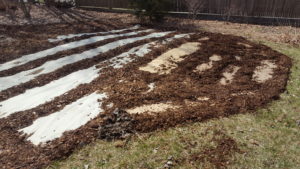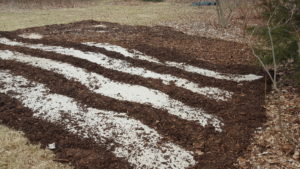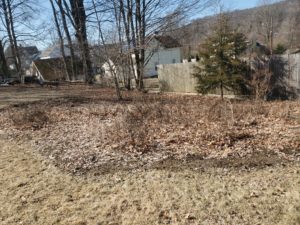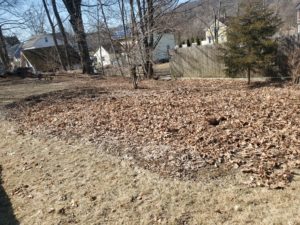By Leslie Duthie
The lawn takes on many connotations for all of us. It is a place to meet, a place for kids to play, to relax, the ultimate suburban habitat. Lawns can also be hard work – our lawns need water and require fertilizer to keep that deep green lushness yet provide little in the way of habitat or ecological value for anything other than humans. From an ecological standpoint, I started to rethink the importance of the “lawn” and to consider a smaller lawn or lawn alternatives that do not require fertilizer, water, or much mowing. Ultimately, I decided the best solution would be to replace the lawn with new gardens.
I have never used much fertilizer or water on the lawn, so it is a mix of weeds, dandelions, violets, pussytoes, clover, and some turf. As a result, I can forgo mowing for more extended periods, forget watering, and do without the fertilizer entirely. It may not look great all year, but it was useful when my children were young and needed places to play and gather with friends. Now that the children are grown and my husband and I built a patio for gathering, it was time to reduce the lawn.
Bring on the Cardboard
In the past, I would have undertaken the long and arduous task of removing whatever sod or plants that were impeding the creation of new garden spaces. That digging also meant losing whatever topsoil and organic matter accumulated in the soil and creating a large pile of sod to compost. I could use herbicides or solarize the lawn by covering it with clear plastic, but what else was being killed in the process?
None of those options seemed appropriate, so in the early spring of 2020, stuck at home, I undertook lawn murder using a different method. A method I found to be easy and manageable no matter your space’s size. The pandemic required each of us to purchase items online that were delivered to our houses. Groceries, pet supplies, furniture, home improvement, and organizational items all came in a box. I began collecting cardboard boxes (preferably plain brown ones with little printing) and realized that I could also scavenge my neighbor’s cardboard boxes on recycling day.
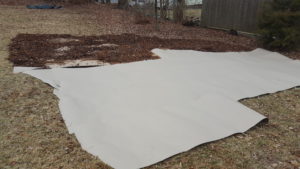
Rather than digging or using herbicides to kill the lawn, I could lay pieces of cardboard over the surface of the grass to smother it. Cardboard degrades quickly while also smothering whatever plants are beneath it. I was fortunate to have access to a large amount of decomposing wood chips to hold the cardboard in place. Other than decomposed wood chips, you can consider using small logs, branches, manure, compost, or just soil to keep the cardboard in place.
Once I had used up all my collected cardboard, I realized I wanted more. I purchased Ram Board at my local hardware store. Ram Board is cardboard material used by renovators to protect your floors during remodeling. It comes in large rolls and can be cut to any length. You can see in the picture below that I used a lot of woodchips to hold down boxes of various sizes. On the Ram Board, I only had to put chips along the seams of the cardboard. Finally, after covering a large rectangular area, I wanted to shape my new garden area, so I retrieved additional boxes and used them to make a more rounded area rather than another big square. In all, I have killed almost 1000 square feet of former lawn.
- I extended the garden edges to prevent having a ‘square’ garden.
- Wood chips hold down the cardboard.
Planting Time for the Annual Seeds
At this point, several options are available: The cardboard needs some kind of cover to help it stay moist and degrade while opening up a planting area. A light coating of compost or soil would be sufficient to break down the cardboard, and I could begin planting in late summer or early fall. I could have applied the decomposed wood chips across the entire surface and allowed them to decompose with the cardboard, in which case I could plant the following year. I was ready to plant the first spring, so instead, I ordered a mix of topsoil and compost and covered all of the cardboard and wood chips with a 2” to 4” layer of soil.
I have expanded my narrow strip garden along a fence line into a larger garden bed. There is a saucer magnolia at the back corner of the new garden, and I left a red cedar and blueberries along the fence. That existing strip of the garden already has many sun-loving perennials, species you would find in a meadow. My goal was to use the expanded garden area to create a more meadow-like setting in this section of the yard and to attract more wildlife to my corner of suburbia.
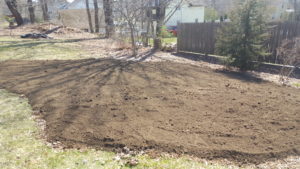
A mix of soil and compost covers the cardboard and woodchips.
I had some plants in mind for this site, but I decided to use an annual cover crop to go along with the small plugs and transplants planned for this garden. I purchased some partridge pea seeds (Chamaecrista fasciculata) and scattered them across the soil’s surface. I had also picked up some seeds at last year’s ELA conference and scattered those across the surface of the soil. I decided that if some germinated and grew, it was a bonus for me.
Fortunately, we had plentiful early spring rains, which allowed the seed to nestle into the new soil, and germination soon took place. Since I started my lawn murder in mid-March and seeded in early April, it would be another four to eight weeks before the plugs would be big enough to plant. I purchased some plugs and grew some of my own in anticipation of planting.
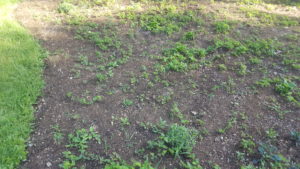
Germination and transplants are beginning to grow.
Mid-May is Plug Planting Time
In mid-May, I added transplants and plugs to the newly germinating partridge pea (Chamaecrista fasciculata). My selections included:
Perennials
- dotted horsemint (Monarda punctata)
- golden alexanders (Zizia aurea)
- sundrops (Oenothera fruticosa)
- purple giant hyssop (Agastache scrophulariifolia)
- bee balm (Monarda didyma)
- purple coneflower (Echinacea purpurea)
- mountain mint, two varieties, (Pycnanthemum muticum and P. tenuifolium)
- goldenrod, three varieties, (Solidago puberula, S. odora, S. speciosa)
Annuals
- lemon mint (Monarda citriodora)
- partridge pea (Chamaecrista fasciculata)
Grasses
- little bluestem (Schizachyrium scoparium)
- Indian grass (Sorghastrum nutans)
It sounds like a lot of planting. I generally planted about a dozen of each plant. There are some individual plants, and other species are more abundant as I did anticipate some losses, and I knew it would take time for them to mature.
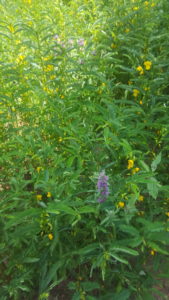
Agastache scrophulariifolia (purple giant hyssop) and Chamaecrista fasciculata (partridge pea)in bloom.
The summer of 2020 was quite hot and dry. We had long rain-free periods, and I had sworn at the start that I would not water. However, I found some watering was necessary, especially when the plants first went into the ground and some during the summer.
I was amazed at what I found in mid-summer as the partridge pea (Chamaecrista fasciculata) – my annual cover crop – matured. The whole patch buzzed with the sounds of all types of bees! I loved being out in the garden and would sometimes move through the partridge pea, removing some of it to give my little plugs some space. I did not remove a lot of the partridge pea as it is an annual, and I anticipate seeing more of the perennial species this coming summer.
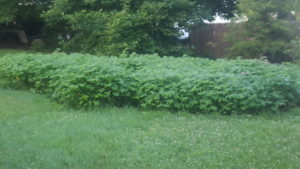
Mature partridge pea in bloom.
The back section of the new garden by the magnolia is shady, so there I adjusted my planting theme from sun-loving meadow species and incorporated shade loving perennials. Again, I transplanted some plants from my own yard and purchased small plants and plugs. I have used a mixture of wild ginger (Asarum canadense), green and gold (Chrysogonum virginianum), and Christmas fern (Polystichum acrostichoides) for this shadier area.
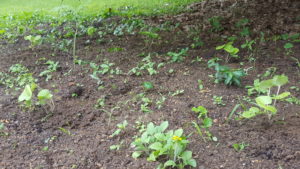
Asarum canadense (wild ginger) and Chrysogonum virginianum (green and gold) get a good start in the shade garden.
A New Garden Is Born
Once the plants began to grow, and the partridge pea began to flower, I did minimal weeding. I removed plants like pigweed and burdock, but I tried to leave the garden to grow on its own. Some of the seeds (Agastache, Monarda) grew and bloomed in summer, as did some of the plugs (Monarda, Solidago), but the partridge pea was the star of the first-year garden.
I was so happy with the garden that in the fall, I expanded it towards the back of the property – around the magnolia connecting to the shade garden along the property line. This time I used my own compost for the expansion. It was a smaller area, and I wanted to use what I had on hand. I collected some of the partridge pea seeds from the garden and will use those in the new section this spring. I did not use wood chips on the smaller area because I had the compost ready to go.
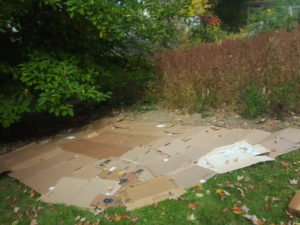
Additional cardboard laid out in the fall then covered with compost. The partridge pea went to seed (the brown stalks in the garden), and some of the larger perennials are flagging in the drought.
I didn’t cut back the garden in the fall of 2020. I pulled some of the partridge pea, and this spring, I took down the old stalks before growth started again. I also left the fallen leaves on the bed to help enrich the soil. I can’t wait to see the progress this year. I will again vow not to use water or fertilizer. I anticipate more weeding this year but will try to keep my efforts to a minimum. My plugs have rooted in and started to form larger clumps, and I expect there will be less partridge pea in the main section this year (although I did hear all those seed pods popping open last fall!)
- The garden before the partridge pea stalks were removed and after the stalks were removed.
I hope my story invites you to try this method for developing new gardens. The bulk of the work was laying the cardboard and spreading the soil. I did the back section (10×10’) in a few hours last fall just using the cardboard and compost I had on hand. Now is the perfect time to consider killing your lawn (or part of it). While it is too early to work the soil, it is the right time to spread out that cardboard and consider a new garden space.
Photo credit for the banner image Bob Peterson Wikimedia Commons.
About the Author
Leslie Duthie is a lifelong gardener. She was formerly employed at the Norcross Wildlife Sanctuary, where she was the horticulturist and plant propagator for over 38 years. An accomplished grower of ferns and wildflowers, Leslie’s love of ferns began when she first learned how to raise them from spores. Now retired, she volunteers at various gardens and works to protect land for her local Conservation Commission and land trust.
***
Each author appearing herein retains original copyright. Right to reproduce or disseminate all material herein, including to Columbia University Library’s CAUSEWAY Project, is otherwise reserved by ELA. Please contact ELA for permission to reprint.
Mention of products is not intended to constitute endorsement. Opinions expressed in this newsletter article do not necessarily represent those of ELA’s directors, staff, or members.

